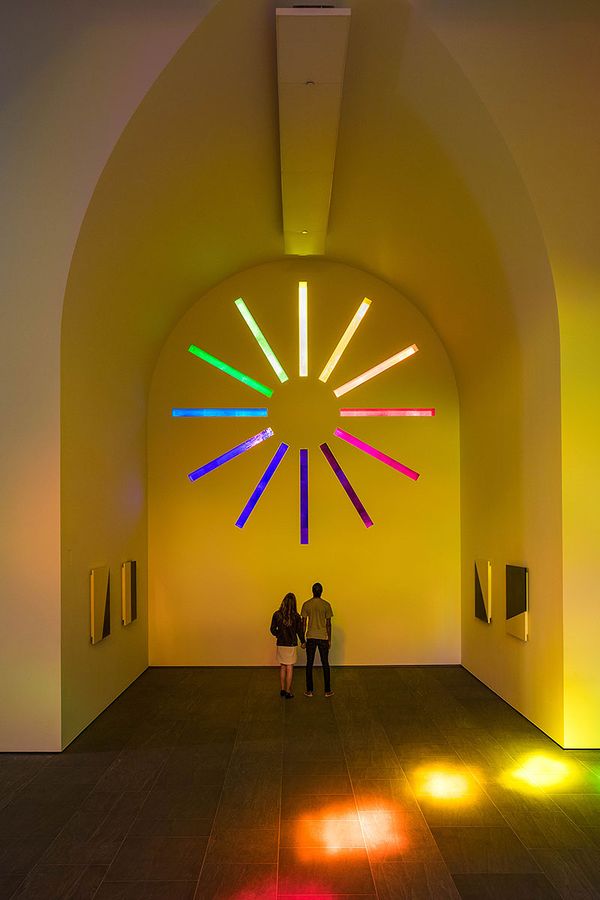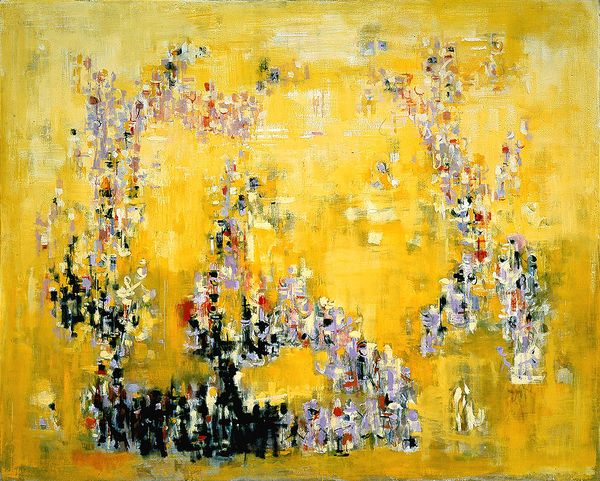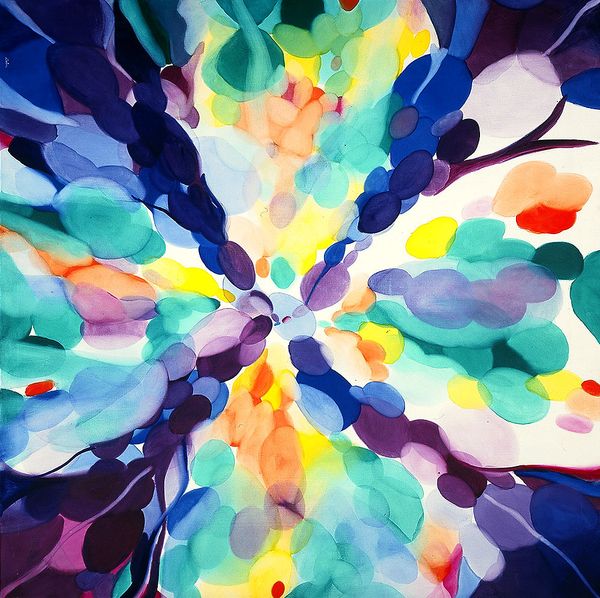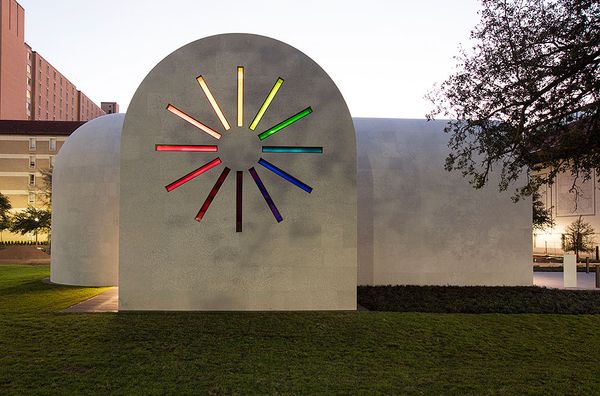Ellsworth Kelly, Austin, 2015 (West façade). Artist-designed building with installation of colored glass windows, black and white marble panels, and redwood totem. ©Ellsworth Kelly Foundation. Courtesy Blanton Museum of Art, The University of Texas at Austin.
The Austin area draws visitors from all over the world, and many have Ellsworth Kelly’s 'Austin' on their bucket list — it’s become quite an art destination. —Carter Foster
PHILLIPS: Tell us what you think makes the Blanton both a regional and an international art museum.
CARTER FOSTER: We are regional in that we serve students, faculty, and staff of The University of Texas (for whom admission is always free) and the broader Austin and Central Texas audience, a thriving, growing community. We collect and show the work of Texas artists as well, some of whom have international stature, some of whom are better known locally or are deeply associated with the culture and milieu of Texas — someone like Terry Allen, who is in both categories, I would say.
Our collections are also international, with strengths in early modern European art, particularly the 17th and 18th centuries. Latin American art has long been a focus; we’ve organized several major exhibitions in this area over the past few years, including The Avant-garde Networks of Amauta: Argentina, Mexico, and Peru in the 1920s, which travelled to three countries before its current presentation here. More recently we have built a program around Art of the Spanish Americas, making important acquisitions and establishing a curator dedicated to that field, Rosario Granados. Of course, the Austin area draws visitors from all over the world, and many have Ellsworth Kelly’s Austin on their bucket list — it’s become quite an art destination.

Ellsworth Kelly, Austin, 2015 (West façade). Artist-designed building with installation of colored glass windows, black and white marble panels, and redwood totem. ©Ellsworth Kelly Foundation. Courtesy Blanton Museum of Art, The University of Texas at Austin.
P: “Austin”, the final legacy of Ellsworth Kelly opened at the Blanton in 2018. Can you tell us more about the roots of this relationship?
CF: That is an interesting question for me personally because Ellsworth was a friend of mine and I wrote about the building that would become Austin before it was ever built, in 2010. This was well before I worked at the Blanton, and a few years later Ellsworth started telling me about how the project was actually taking off in Texas. One of our board members, Jeanne Klein, had heard about it from a UT alum, Hiram Butler, and eventually our director Simone Wicha and former UT president Bill Powers took up the mantle and made it happen, all rather quickly as these things go.
After building a relationship with the artist, the Blanton team worked diligently to get such a structure completed. But as we can all see, the spectacular results are now here for all to enjoy forever. I came to work at the Blanton in part because the museum had invited me to speak on a panel about Ellsworth and the building just before groundbreaking, and one thing led to another.

Norman Lewis, La Puerto Del Sol, 1958. Blanton Museum of Art, The University of Texas at Austin, Gift of the Longview Foundation, Inc., 1960. © Estate of Norman Lewis; Courtesy of Michael Rosenfeld Gallery LLC, New York, NY.
P: Your upcoming exhibition, "Expanding Abstraction" explores painting from 1958-1983. Is this exhibition an opportunity to rethink the canon of Abstract American Art?
CF: I hope so! There is a lot to be re-thought, in my opinion. The exhibition will include works by both North and South American artists — it will combine some highlights from our post-war collection of American painting, which is particularly strong in works of the 1960s and 70s, with Latin American works from the same era. It has been a pleasure to discover some impressive artists in our collections who I, for one, had never heard of before. The painter Alice Baber, for example, who made incredible, psychedelic abstractions. And the Texas artist Dorothy Hood, who is just fantastic and is finally becoming better known. Putting their work front and center next to better known figures such as Morris Louis, Helen Frankenthaler, and Jules Olitski, I know they will totally hold their own, which is exciting.
The largest work in the exhibition is a stunning painting by Oliver Lee Jackson, which we received as a gift a few years ago. Jackson just had a major exhibition at the National Gallery in Washington, and like many of his fellow African-American artists, such as Sam Gilliam, Norman Lewis, and Alma Thomas (also all in the show), he is getting long-overdue recognition. All of them should be firmly in the canon of 20th-century painting!

Alice Baber, Lavender High, 1968. Blanton Museum of Art,The University of Texas at Austin, Michener Acquisition Fund, 1969.
P: During this challenging period, how does the Blanton continue to engage the public in its programs?
CF: Like almost everyone, we quickly adapted our programming for the digital space. In early April we launched Curated Conversations, a series of free online talks featuring Blanton staff and guest speakers. These events have taken deep dives into individual works of art, shared behind-the-scenes stories about various museum roles, and presented thematic mini-exhibitions. Just after the Fourth of July, we had a popular program about the imagery and symbolism of flags in art, a discussion which also allowed us to explore issues of social justice in the work of artists like Charles White and Barbara Jones-Hogu.
Another popular one featured our curators of Latin American art, Vanessa Davidson and Florencia Bazzano-Nelson, discussing Mail art — artists co-opting the postal service in their work. That one drew quite an international audience! Doing these talks online has been interesting because it has allowed us to reach a broader audience. When you don't have to fly in a speaker and people can tune in from home, everything is just more convenient, and we plan to continue to do online programming for the foreseeable future, likely continuing even after the pandemic crisis is over.
We also introduced our multimedia Virtual Visits, which are virtual tours filmed with a 360-degree camera that replicate the experience of walking through our galleries, augmented by audio and video commentary. And we’ve continued to make a great deal of our past programming accessible online. For example, our website features a robust resource dedicated to Race and Social Justice, incorporating recorded lectures, artist talks and interviews, and more digital offerings related to this obviously very timely topic.

Ellsworth Kelly, Austin, 2015 (Interior, facing east). ©Ellsworth Kelly FoundationPhoto courtesy Blanton Museum of Art, The University of Texas at Austin.

